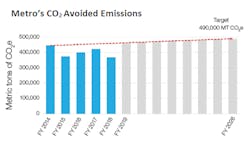Washington Metropolitan Area Transit Authority (WMATA) is undertaking its first Energy Action Plan, which is a detailed five-year roadmap to reduce energy usage, cut greenhouse gas emissions and generate up to $29 million annually in energy and operational cost savings.
"[WMATA] connects the region through affordable, sustainable transportation every day helping to reduce the region's carbon footprint," said WMATA General Manager and Chief Executive Officer Paul J. Wiedefeld. "Together, with our riders, we are making the right choice for the environment by changing the way we do business through reduced consumption and efficiencies that will generate long-term cost savings."
The authority has committed to investing $65 million from its capital budget by 2025 toward energy efficient technology, modernizing operations, promoting innovation and reducing operating costs to support a sustainable future. WMATA estimates that the net energy savings resulting from the Energy Action Plan will be the equivalent of taking 35,000 vehicles off the road each year. Fully implemented, the Energy Action Plan is expected to net $16 million annually in energy cost savings and another $13 million in savings on operations and maintenance expenses by 2025.
The transit provider has already taken steps to implement elements of the Energy Action Plan including the design of its Potomac Yard Station to be the first LEED Certified transit station in the U.S., likewise, WMATA's new headquarters building near L'Enfant Plaza will also be designed to LEED platinum standards and the authority is developing an electric bus deployment strategy to pilot and evaluate the use of electric buses in the fleet.
WMATA notes that taking transit is an individual action that can contribute to reducing the region's carbon footprint. To illustrate this, WMATA launched a sustainability calculator April 22 on its Trip Planner available at wmata.com. WMATA says by providing nearly 1 million passenger trips each weekday, it saves 1,110 metric tons of CO2 daily, which is the equivalent of:
- Burning 125,000 gallons of gasoline
- Energy to power 48,500 homes
- Electricity to charge 140 million cellphones
WMATA also relies on new technology to further reduce energy use and costs, such as regenerative braking on its new railcars, its net-zero water treatment facility in Largo, which uses gravity-fed treatment tanks and solar panels to treat water from tunnels, and new LED trackbed lighting that has been installed at 23 underground rail stations with upgrades planned at all 48 stations and additional WMATA facilities over the next two years.
"An ever greener [WMATA] system is the cornerstone of a more resilient and more sustainable Greater Washington DC area," said Jim Foster, president of the Anacostia Watershed Society. "Taking [WMATA] instead of driving is one of the most effective things individuals can do to reduce their own carbon footprint. [WMTA's] ambitious Energy Action Plan will make this even more true in the future."
About the Author

Mischa Wanek-Libman
Group Editorial Director
Mischa Wanek-Libman is director of communications with Transdev North America. She has more than 20 years of experience working in the transportation industry covering construction projects, engineering challenges, transit and rail operations and best practices.
Wanek-Libman has held top editorial positions at freight rail and public transportation business-to-business publications including as editor-in-chief and editorial director of Mass Transit from 2018-2024. She has been recognized for editorial excellence through her individual work, as well as for collaborative content.
She is an active member of the American Public Transportation Association's Marketing and Communications Committee and served 14 years as a Board Observer on the National Railroad Construction and Maintenance Association (NRC) Board of Directors.
She is a graduate of Drake University in Des Moines, Iowa, where she earned a Bachelor of Arts degree in Journalism and Mass Communication.
